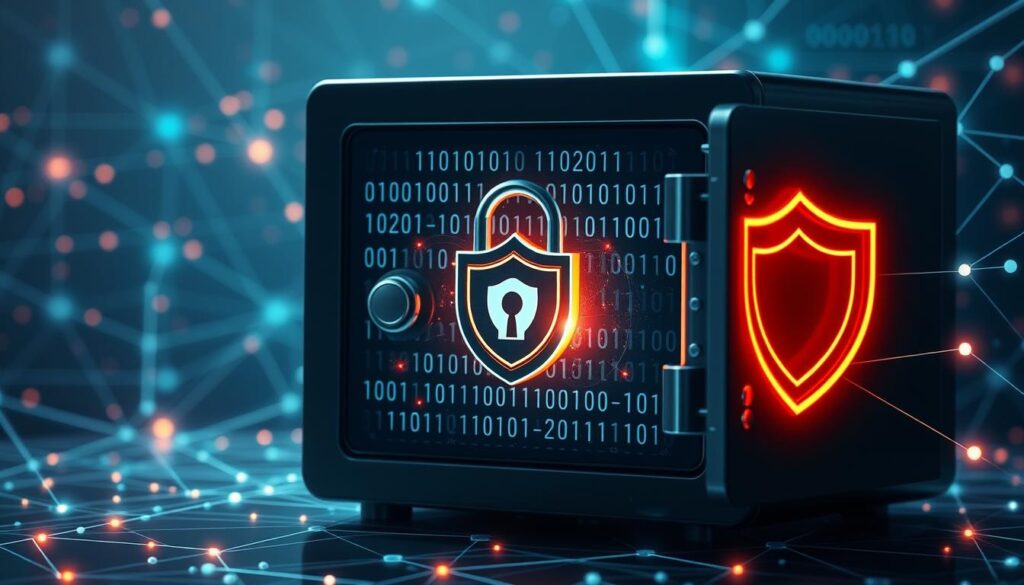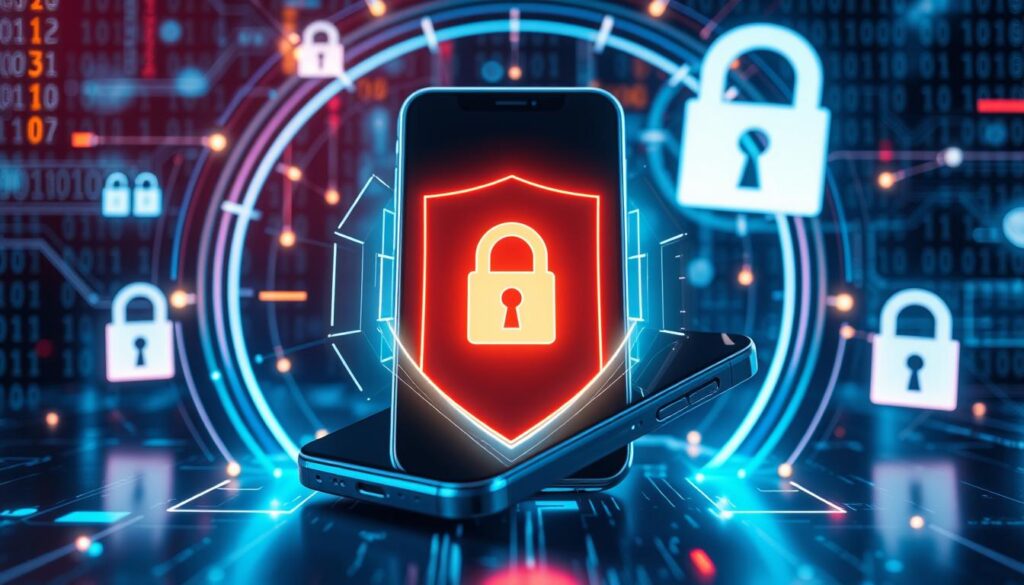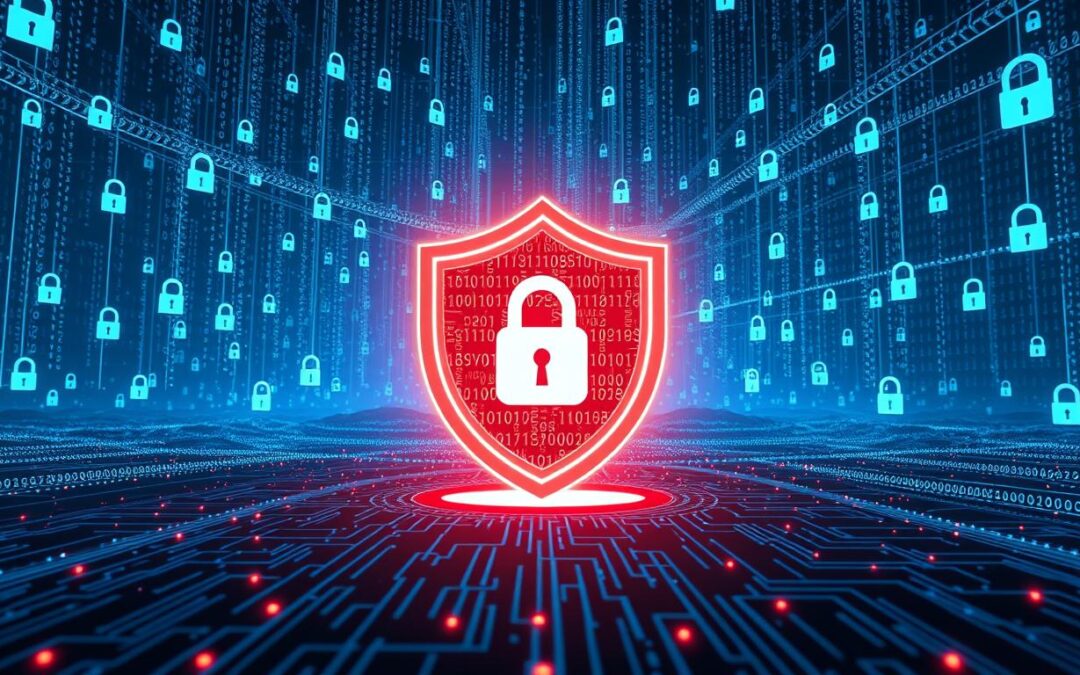Cybercrime is expected to cause damages of $6 trillion globally by 2021. This shows how crucial cybersecurity is. The global cybersecurity market is set to hit $345.4 billion by 2026, growing at 10.9% annually. Cybersecurity protects our digital devices, networks, and data from harm.
With technology and the internet on the rise, we’re more connected than ever. But this connection also makes us more vulnerable to cyber threats. Cybersecurity is key to protecting our devices, data, identities, and way of life.
Cybersecurity is more important than ever. Understanding it is vital in today’s world. In 2021, the average cost of a data breach was about $4.24 million, according to IBM. This highlights the need for strong network protection and cybersecurity.
Key Takeaways
- Cybercrime is expected to cause significant damages globally, emphasizing the importance of cybersecurity measures.
- Cybersecurity refers to the measures taken to protect our digital devices, networks, and data from unauthorized access, theft, and malicious attacks.
- Effective cybersecurity and data security practices are crucial in protecting our identities and our way of life.
- The global cybersecurity market is projected to reach $345.4 billion by 2026, reflecting a CAGR of 10.9%.
- Network protection and cybersecurity measures are essential in preventing cyber threats and protecting our digital devices and data.
Understanding Modern Cybersecurity Threats
Cyber threats are getting more complex. It’s key to know the different types of threats out there. From phishing scams to ransomware attacks, these threats can harm our personal and work lives. Keeping safe online is vital to protect ourselves.
In today’s world, keeping our information safe is a big deal. With more technology, we’re more connected than ever. This connection brings new risks. We need strong cyber defense to fight these risks.
Common Types of Cyber Attacks
- Phishing scams
- Ransomware attacks
- Malware infections
These attacks can cause big problems, like losing money and damaging our reputation. It’s important to know about these threats. We should protect ourselves with strong cyber defense and safe online habits.
The Evolution of Digital Threats
Cyber threats are always changing. It’s crucial to stay updated. By knowing the latest threats and taking steps to protect ourselves, we can lower the risk of cyber attacks. This helps keep our information security safe.
Essential Components of Personal Cybersecurity
Protecting yourself online is key in today’s world. Online privacy is a big worry, as cyberattacks are rising. To fight these, you need to act early. This means making strong passwords, using two-factor authentication, and updating your software.
Here are some important steps for personal cybersecurity:
- Use multi-factor authentication to stop automated attacks
- Have a formal incident response plan to lower breach costs
- Do regular security awareness training to avoid mistakes
By following these steps, you can lower your risk of cyberattacks. It’s vital to keep up with the latest digital threat prevention tips. This way, you can stay safe online.
Creating and Managing Strong Passwords
Strong passwords are key to data security and a vital part of network security measures. A strong password guards against cyber threats. It’s important to have a unique password for each account. Mixing uppercase and lowercase letters, numbers, and special characters makes a password strong.
Recent stats show 80% of data breaches come from weak or stolen passwords. This shows how crucial strong passwords are. Using password managers can help create unique passwords for different accounts, lowering the risk of data breaches.

For strong passwords, aim for at least 12 characters. Include uppercase and lowercase letters, numbers, and symbols. Never use the same password for different sites to avoid credential stuffing attacks. Multi-factor authentication adds extra security, needing more than one credential to log in.
Password Best Practices
- Create unique passwords for each account
- Use a combination of uppercase and lowercase letters, numbers, and special characters
- Avoid reusing passwords across multiple sites
- Use a password manager to generate and store strong passwords
By following these tips and using network security measures like password managers and multi-factor authentication, you can greatly lower data breach risks. This helps protect your data security.
Securing Your Home Network
To keep your personal devices and data safe, securing your home network is key. Internet safety and cyber defense are vital. Many home network breaches happen because of outdated or unsecured devices.
Modern operating systems have security features to fight off common cyberattacks. Turning on automatic updates and applying patches monthly can help. Also, setting up routers with WPA3 and using strong passphrases can boost cyber defense.
Here are some important steps to secure your home network:
- Disabling WPS and UPnP to prevent unauthorized access
- Using a password manager for unique and complex passwords
- Enabling firewall capabilities and network address translation (NAT)
- Scheduling weekly reboots for devices, including routers and smartphones
By taking these steps and keeping up with internet safety practices, you can lower cyber threat risks. Remember, keeping your home network secure is an ongoing task. It needs regular updates and care to stay safe.
Safe Browsing Habits and Digital Hygiene
Keeping yourself safe online means following safe browsing habits and good digital hygiene. It’s important to be careful with emails and avoid phishing attacks. About 91% of successful cyber attacks start with a phishing email.
To stay safe, always check who sent the email. Don’t click on links or download attachments from people you don’t know.
Good digital hygiene includes keeping software up to date and using strong passwords. Digital threat prevention tools like antivirus software and firewalls can also protect you. Remember to check your online privacy settings to keep your personal info safe.
To boost your online security, use a password manager and enable two-factor authentication. Be careful when using public Wi-Fi too. By following these tips, you can lower your risk of cyber attacks and keep your online privacy safe.
Mobile Device Protection Strategies
Mobile devices are a big part of our lives. Keeping them safe is key for our security. With more use of mobiles in public Wi-Fi, they face more cyber risks. It’s vital to have strong mobile security plans for network protection and information security.
Some good strategies include:
- Enabling remote tracking and wiping features
- Being cautious when downloading apps
- Using strong passcodes, PINs, or biometric authentication
A Check Point Research report shows 97% of firms have faced mobile threats. It’s important to use information security steps like data encryption and updates. This helps keep mobiles safe from cyber threats.

By using these strategies and staying alert to threats, we can keep our mobiles and data safe. This helps protect our sensitive info from hackers, keeping our network protection strong.
Data Encryption and Backup Protocols
Keeping your data safe is key in today’s digital world. Data security steps are vital to stop unauthorized access. Data breaches happen often, so protecting your data is crucial.
Backing up your data and keeping it safe is important. It helps avoid losing your data.
Encryption is a big part of cyber defense. It uses algorithms like AES and RSA to keep information safe. AES-256 is top for protecting data at rest, making it hard to crack.
Encryption has many benefits:
- It keeps data safe from unauthorized access.
- It makes sure data stays private and safe.
- It meets rules like HIPAA and GDPR.
Strong encryption helps stop data breaches. Using safe storage is also key. By focusing on data security and cyber defense, you lower the risk of data loss.
Encryption is a must for a strong cyber defense plan. It should work with other security steps to protect your data. Being proactive with data security helps prevent breaches and keeps your data safe for the long term.
Social Media Privacy and Security
Almost 4.8 billion people use social media worldwide, which is about 59% of the global population. It’s key to focus on online privacy and stopping digital threats. Social media is a big part of our lives online, so keeping our privacy and security is very important.
When employees share too much on social media, it can lead to big risks. These risks include spear phishing, whaling attacks, and spoofing. Cybercriminals can use the info shared to launch social engineering attacks. To fight these risks, having a strong social media policy and following security rules is crucial.
Account Privacy Settings
Using two-factor (2FA) or multi-factor (MFA) authentication helps protect accounts from unauthorized access. But, about 60% of social media users don’t check their privacy settings often. This makes them open to cyber threats. It’s important to check and change your social media privacy settings often to keep your online privacy safe.
Information Sharing Guidelines
Personal quizzes and puzzles can help cybercriminals guess your security questions. This can lead to your identity being stolen. So, it’s smart to be careful about what you share on social media. By being careful, you can lower the chance of cyber attacks.
Digital Footprint Management
About 50% of people feel uneasy sharing personal info on social media because of privacy worries. By managing your digital footprint, like checking privacy settings and being careful with what you share, you can keep your online privacy safe. This helps prevent digital threats.
Identity Theft Prevention Measures
Identity theft is a big worry, with 1,506 data breaches in the U.S. in 2019. This led to 164.68 million sensitive records being exposed. To fight identity theft, we must take network security measures and protect our data security. This means being careful with our personal info, checking our credit reports, and using two-factor authentication.
Here are some important steps to stop identity theft:
- Watch out for phishing attempts and malware that can track your computer activity
- Make strong passwords and keep them secret
- Stay away from public Wi-Fi hacking by using a VPN
The cost of a data breach hit a record high of $4.45 million in 2023. So, it’s key to act fast to protect against identity theft and keep our data security strong. By using strong network security measures and being careful with our personal info, we can lower the risk of identity theft a lot.
Conclusion: Building Your Digital Security Framework
Building a strong digital security framework is key to protecting yourself online. We’ve covered many important topics, like making strong passwords and keeping your mobile devices safe. These cyber defense, online privacy, and digital threat prevention tips are a great start to boost your digital security.
As threats online grow, staying alert and up-to-date with security tips is vital. Keeping your software current and watching for threats can help a lot. The digital world keeps changing, so your security plan must too.
Using the advice from this article, you can create a solid digital security plan. This will protect your personal and financial info, and help you feel safe online. Adopting these strategies will make you more secure and confident in the digital world.

